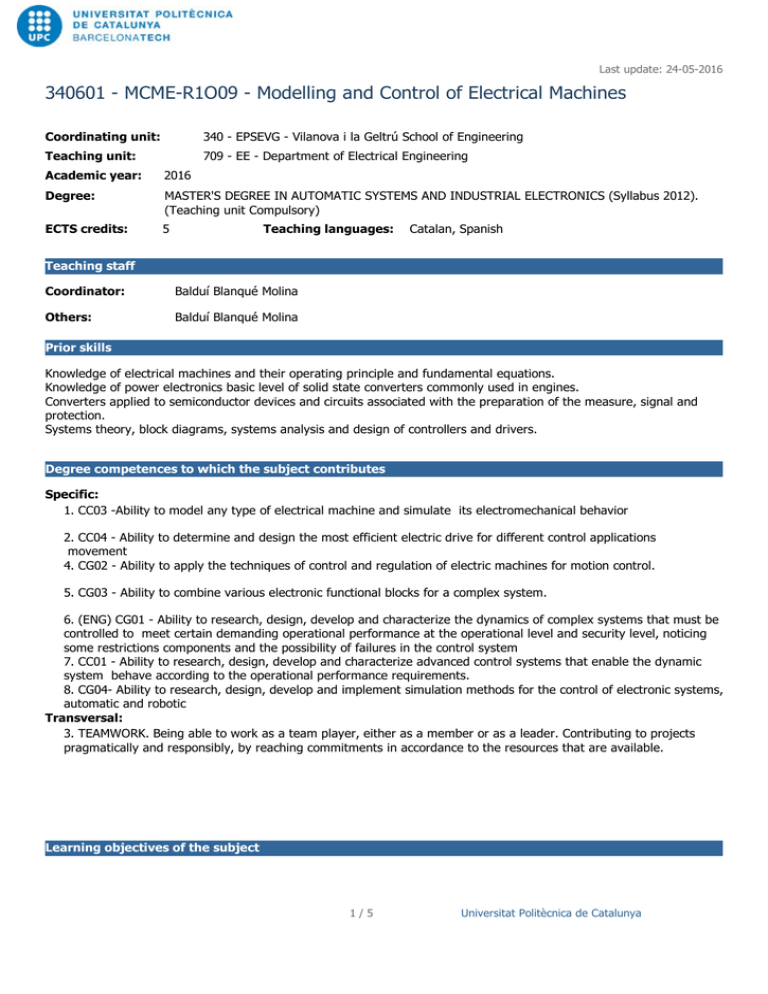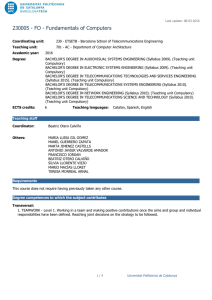MCME-R1O09 - Modelling and Control of Electrical Machines
Anuncio

Last update: 24-05-2016 340601 - MCME-R1O09 - Modelling and Control of Electrical Machines Coordinating unit: 340 - EPSEVG - Vilanova i la Geltrú School of Engineering Teaching unit: 709 - EE - Department of Electrical Engineering Academic year: 2016 Degree: MASTER'S DEGREE IN AUTOMATIC SYSTEMS AND INDUSTRIAL ELECTRONICS (Syllabus 2012). (Teaching unit Compulsory) ECTS credits: 5 Teaching languages: Catalan, Spanish Teaching staff Coordinator: Balduí Blanqué Molina Others: Balduí Blanqué Molina Prior skills Knowledge of electrical machines and their operating principle and fundamental equations. Knowledge of power electronics basic level of solid state converters commonly used in engines. Converters applied to semiconductor devices and circuits associated with the preparation of the measure, signal and protection. Systems theory, block diagrams, systems analysis and design of controllers and drivers. Degree competences to which the subject contributes Specific: 1. CC03 -Ability to model any type of electrical machine and simulate its electromechanical behavior 2. CC04 - Ability to determine and design the most efficient electric drive for different control applications movement 4. CG02 - Ability to apply the techniques of control and regulation of electric machines for motion control. 5. CG03 - Ability to combine various electronic functional blocks for a complex system. 6. (ENG) CG01 - Ability to research, design, develop and characterize the dynamics of complex systems that must be controlled to meet certain demanding operational performance at the operational level and security level, noticing some restrictions components and the possibility of failures in the control system 7. CC01 - Ability to research, design, develop and characterize advanced control systems that enable the dynamic system behave according to the operational performance requirements. 8. CG04- Ability to research, design, develop and implement simulation methods for the control of electronic systems, automatic and robotic Transversal: 3. TEAMWORK. Being able to work as a team player, either as a member or as a leader. Contributing to projects pragmatically and responsibly, by reaching commitments in accordance to the resources that are available. Learning objectives of the subject 1/5 Universitat Politècnica de Catalunya Last update: 24-05-2016 340601 - MCME-R1O09 - Modelling and Control of Electrical Machines 1. Modeling and control of electric drives. 2. Special attention to the modeling of all stages that constitute a drive and simulation using PSpice and commercial software Matlab / Simulink will be given. 3. In the labs students will be introduced into the specifics of control currently used in the drive industry, introducing rapid prototyping techniques (DSpace) for the actual implementation using DSP's. IN GENERAL: Applications using electric drives require controls position, speed and torque. Today the applications in automated industrial processes and transport vehicles and trains use as precise and efficient motion control. Proper design of the whole minimizes energy consumption and the size and weight of the machines that move. On this subject the various systems used in the movement of drives (motors, sensors, converters, protocols, standards and control methods) for a wide variety of industrial sectors are covered. The course aims to provide a broad view of the whole applied to real industrial processes. Study load Total learning time: 125h Hours large group: 22h 30m Hours medium group: 0h Hours small group: 22h 30m Guided activities: 0h 0.00% Self study: 80h 64.00% 2/5 18.00% 0.00% 18.00% Universitat Politècnica de Catalunya Last update: 24-05-2016 340601 - MCME-R1O09 - Modelling and Control of Electrical Machines Content 1. Introduction to electric drives applied to speed, position and torque control. Learning time: 6h Theory classes: 2h Laboratory classes: 2h Guided activities: 1h Self study : 1h Description: Introducció als tipus d'accionaments, sistemes elèctrics i mecànics. 2. Modelat dinàmic, Simulació i Control de les màquines elèctriques bàsiques (Continua i Inducció). Learning time: 16h Theory classes: 6h Laboratory classes: 6h Guided activities: 2h Self study : 2h Description: El modelado y la simulación de los accionamientos eléctricos nos permiten comprobar el funcionamiento de estos sin la necesidad de disponer de ellos físicamente, aunque los resultados son aproximados en función de la precisión del modelo. En este punto se mostrarán los diferentes sistemas de modelar que existen para accionamiento eléctricos y se presentarán los primeros modelos de máquina de continua y motor de inducción, realizando la simulación de estos de forma análoga a lo que se experimentará en el laboratorio. Related activities: Ejercicios de conceptos básicos : Se realizan aplicando la simulación para dar apoyo experimental a los conceptos teóricos explicados en la clase de teoria. Alguno de estos ejercicios serán del tipo E1 evaluable y otros del mismo tipo, pero no evaluables. Prácticas de laboratorio: Donde se obtienen los parámetros de los motores que se va a modelar y luego simular. Además también se contrastan los resultados dinámicos obtenidos en la simulación con los obtenidos en el laboratorio. Pudiendose observar a que se deben las similitudes y las diferencias. Práctica 1-2-3 Specific objectives: 1. Distinguir los diferentes tipos de modelado, relacionados con los parámetros que se desean analizar u observar en la simulación. 2. Saber configurar un accionamiento básico completo (Convertidor, drivers, sensores, motor, carga, etc) tanto en la simulación como en el laboratorio emulando o usando una aplicación real. 3. Comparar los resultados obtenidos y mejorarlos para una aplicación concreta. 4. Comprender como interactuan entre si las diferentes variables eléctricas y mecánicas, para saber como controlarlas. 5. Ajustar los diferentes bloques que intervienen en el funcionamiento del accionamiento. 6. Proponer y comprobar diferentes soluciones para un modelado orientado a resultados (En función de que se quiere observar; velocidad, rendimiento, corriente de bus, rizado de par, etc) evaluando el coste que esto tiene y los recursos necesarios para ello. 3/5 Universitat Politècnica de Catalunya Last update: 24-05-2016 340601 - MCME-R1O09 - Modelling and Control of Electrical Machines (ENG) Control escalar y vectorial de las màquines Learning time: 11h 40m elèctriques. Theory classes: 5h Laboratory classes: 3h 20m Guided activities: 1h 40m Self study : 1h 40m Description: Control escalar y vectorial de las màquines elèctriques. 4. Modelat i control d'accionaments no convencionals. Learning time: 6h Theory classes: 1h Laboratory classes: 1h Guided activities: 2h Self study : 2h Description: Modelat i control d'accionaments de Reluctància Autoconmutats. Modelat i control d'accionaments lineals. Planning of activities E1. Concept exercises (20%) Hours: 5h Theory classes: 1h Self study: 2h Guided activities: 2h Ep. Exàmen parcial (20%) Hours: 2h Theory classes: 2h E_lab. Evaluació de pràctiques (30%) Hours: 1h Theory classes: 1h Ef. Exàmen final (30%) Hours: 2h Theory classes: 2h 4/5 Universitat Politècnica de Catalunya Last update: 24-05-2016 340601 - MCME-R1O09 - Modelling and Control of Electrical Machines Bibliography Basic: Mohan, Ned. Electric drives : an integrative approach. Minneapolis: MNPERE, 2003. ISBN 0966353013. Dubey, Gopal K. Fundamentals of electrical drives. 2nd ed. Pangbourne: Alpha Science, cop. 2001. ISBN 084932422X. Bose, Bimal K. Power electronics and motor drives : recent advances and trends. Oxford: Academic, 2006. ISBN 0120884054. Miller, T.J.E. Brushless permanent-magnet and reluctance motor drives. Oxford: Oxford University Press, 1989. ISBN 0198593694. Complementary: Ong, Chee-Mun. Dynamic simulation of electric machinery : using MATLAB/SIMULINK. Upper Saddle River, N.J: Prentice Hall, 1998. ISBN 0137237855. Others resources: Hyperlink http://www.iea.org/publications/freepublications/publication/EE_for_ElectricSystems.pdf http://www.iea.org/publications/freepublications/publication/EE_for_ElectricSystems.pdf 5/5 Universitat Politècnica de Catalunya
